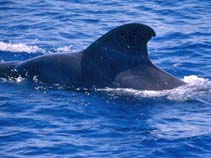Globicephala macrorhynchus Gray, 1846
Short-finned pilot whale| Native range | All suitable habitat | Point map | Year 2050 |

|
| This map was computer-generated and has not yet been reviewed. |
| Globicephala macrorhynchus AquaMaps Data sources: GBIF OBIS |
Classification / Names Tên thường gặp | Các synonym ( Các tên trùng) | CoL | ITIS | WoRMS
Mammalia | Cetartiodactyla | Delphinidae
Environment: milieu / climate zone / Mức độ sâu / distribution range Sinh thái học
Tầng nổi; không di cư (Tài liệu tham khảo 75906); Mức độ sâu 0 - 2418 m (Tài liệu tham khảo 116169), usually 600 - 1000 m (Tài liệu tham khảo 104603). Tropical; 15°C - 16°C (Tài liệu tham khảo 97344); 90°N - 90°S, 180°W - 180°E
Distribution Các nước | Các khu vực của FAO | Các hệ sinh thái | Những lần xuất hiện | Những chỉ dẫn
Atlantic Ocean and Indo-Pacific. Tropical and warm temperate.
Length at first maturity / Bộ gần gũi / Weight / Age
Chín muồi sinh dục: Lm 316.0, range 290 - 400 cm Max length : 610 cm TL con đực/không giới tính; (Tài liệu tham khảo 1394); 550 cm TL (female); Khối lượng cực đại được công bố: 3.6 t (Tài liệu tham khảo 1394)
Life cycle and mating behavior Chín muồi sinh dục | Sự tái sinh sản | Đẻ trứng | Eggs | Sự sinh sản | Larvae
Main reference
Các tài liệu tham khảo | Người điều phối | Người cộng tác
Tan, J.M.L. 1995 A Field Guide to the Whales and Dolphins in the Philippines. Makati City: Bookmark. 125 p. (Tài liệu tham khảo 936)
IUCN Red List Status
(Tài liệu tham khảo 130435: Version 2025-1)
CITES status (Tài liệu tham khảo 108899)
CMS (Tài liệu tham khảo 116361)
Threat to humans
Human uses
Các nghề cá: Tính thương mại
FAO - Các nghề cá: landings, species profile | FishSource | Biển chung quanh ta
Các công cụ
Thêm thông tin
Max. ages / sizes
Length-weight rel.
Length-length rel.
Length-frequencies
Mass conversion
Sự phong phú
Các nguồn internet
BHL | BOLD Systems | CISTI | DiscoverLife | FAO(Các nghề cá: species profile; publication : search) | Fishipedia | GenBank (genome, nucleotide) | GloBI | Gomexsi | Google Books | Google Scholar | Google | PubMed | Cây Đời sống | Wikipedia (Go, tìm) | Tạp chí Zoological Record



